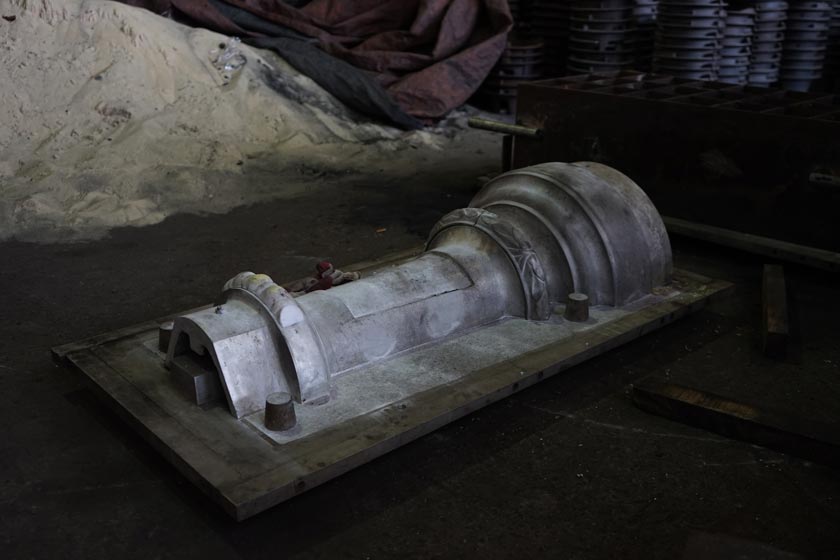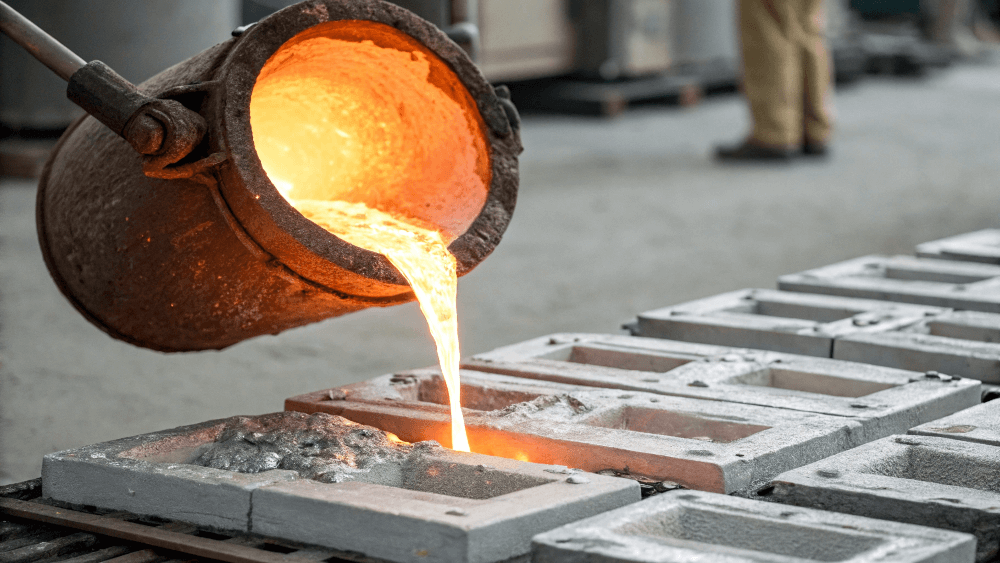Discover how Aluminum Foundry Wisconsin helps create better casting outcomes
Exactly How Aluminum Foundry Adds To Improvements in Aerospace Engineering
Aluminum shops are important to improvements in aerospace design. They create light-weight, high-strength elements that are vital for modern-day aircraft. With advanced spreading strategies, these shops create complicated geometries that improve architectural honesty. Furthermore, the growth of remarkable Aluminum alloys sustains the industry's focus on gas efficiency and sustainability. Difficulties stay in the manufacturing process. Understanding these aspects discloses the extensive effect of Aluminum on aeronautics's future.
The Value of Lightweight Products in Aerospace Style
As the aerospace sector remains to advance, the importance of light-weight products ends up being increasingly noticeable. The need for effectiveness and sustainability drives engineers to focus on the use of products that decrease general weight without compromising structural honesty. Lightweight products, particularly Aluminum, play a crucial function in improving gas effectiveness, enhancing haul ability, and raising the total performance of aircraft.
The integration of these products enables for innovative layouts, making it possible for suppliers to develop more wind resistant shapes that can hold up against extreme problems. The reduction in weight not only lowers functional costs but likewise adds to a reduced environmental impact, lining up with global initiatives towards sustainability in air travel.
Advanced Casting Techniques in Aluminum Foundries
Advanced casting strategies in Aluminum foundries play an important role in aerospace engineering by making it possible for the manufacturing of light-weight and accurate elements. Innovations in mold and mildew layout and precision casting procedures are important in attaining ideal performance and structural honesty. Furthermore, the growth of light-weight alloys boosts the general efficiency and effectiveness of aerospace applications.
Cutting-edge Mold Design
Cutting-edge mold layout plays a necessary function in the performance and efficiency of Aluminum foundries, specifically within the aerospace industry. By leveraging innovative materials and techniques, modern-day mold and mildews can be crafted to endure heats and pressures, making certain peak performance throughout the spreading process. These layouts frequently include complicated geometries that permit the manufacturing of lightweight yet structurally sound elements, important for aerospace applications. In addition, using computer-aided style (CAD) software application facilitates accurate modeling, enabling foundries to improve and imitate mold layouts prior to physical production starts. This not just boosts the quality of cast components however also minimizes waste and preparation, resulting in substantial price financial savings. In general, ingenious mold and mildew design is a keystone of progress in Aluminum Foundry innovation for aerospace design.
Accuracy Casting Procedures
The performance of innovative mold and mildew designs flawlessly integrates with precision casting processes, which are vital for creating top notch Aluminum parts in aerospace engineering. These procedures, consisting of sand spreading, pass away spreading, and financial investment spreading, ensure the development of intricate geometries with limited tolerances. Advanced strategies like vacuum cleaner spreading and stress die casting enhance the stability and surface area finish of the end products. Precision spreading reduces material waste while making the most of the mechanical homes of Aluminum, critical for aerospace applications. Additionally, employing real-time monitoring and advanced simulation devices throughout the casting procedure permits instant modifications, leading to enhanced quality assurance. Collectively, these precision spreading procedures position Aluminum factories at the center of aerospace innovation, sustaining the sector's need for reliability and performance.
Lightweight Alloy Advancement
As aerospace designers look for to improve fuel performance and performance, light-weight alloy development comes to be a crucial focus in Aluminum factories. These shops utilize advanced spreading methods to develop alloys that offer remarkable strength-to-weight ratios. Developments in alloy make-up, including the incorporation of aspects like lithium and magnesium, make it possible for the production of materials that endure extreme conditions while minimizing general aircraft weight. Strategies such as die spreading and investment casting help with the accuracy production of intricate forms, which are vital for aerospace applications. Furthermore, ongoing research study intends to optimize these alloys for enhanced mechanical buildings and increased durability. By prioritizing light-weight alloy growth, Aluminum factories greatly contribute to the development of aerospace engineering, paving the method for a lot more lasting and reliable airplane styles.

Enhancing Structural Stability Via Aluminum Elements
Aluminum components provide considerable advantages in improving structural stability within aerospace design. Their light-weight nature adds to overall performance while preserving toughness, which is essential for airplane performance. Furthermore, the tension resistance residential properties of Aluminum assistance ensure the resilience and reliability of aerospace frameworks under numerous operational conditions.
Lightweight Product Perks
While conventional materials typically compromise weight for toughness, using Aluminum components in aerospace engineering supplies considerable benefits in structural integrity. Aluminum's lightweight nature adds to general style performance, permitting more streamlined airplane that take in less fuel, thereby boosting sustainability. The material's outstanding strength-to-weight proportion guarantees that parts keep sturdiness without adding unneeded mass. This high quality promotes improved performance and dexterity in flight, as well as maximized payload abilities. Furthermore, Aluminum's resistance to deterioration extends the lifespan of aerospace frameworks, decreasing upkeep costs and improving security. As suppliers progressively embrace Aluminum alloys, the aerospace industry experiences a transformative shift towards extra effective and reliable design services that focus on both efficiency and environmental duty.
Tension Resistance Residences
Although various materials have one-of-a-kind residential properties, Aluminum's remarkable stress and anxiety resistance stands apart as an essential consider improving the architectural honesty of aerospace components. This resistance plays a critical role in guaranteeing that aircraft can endure different operational anxieties, including tiredness, effect, and environmental conditions. Aluminum alloys, particularly crafted for aerospace applications, show high tensile toughness while keeping lightweight qualities, enabling engineers to design much more effective structures - Aluminum Foundry. Additionally, the capability of Aluminum to withstand cyclic loading without significant contortion adds to the durability and reliability of aerospace parts. As innovations continue in Aluminum Foundry strategies, the growth of stress-resistant Aluminum elements promises more renovations in performance, security, and performance across the aerospace industry, strengthening Aluminum's function as a preferred product in contemporary design
Fuel Efficiency Improvements Driven by Aluminum Innovations
As the aerospace market seeks to boost gas performance, ingenious uses of Aluminum have become an essential remedy. Aluminum's lightweight nature significantly decreases airplane weight, permitting for lower gas usage throughout trip. This reduction in weight is essential, as even her explanation small reductions can bring about considerable renovations in overall gas economic climate.
Advanced Aluminum alloys, made for enhanced strength and resilience, enable manufacturers to create elements that preserve architectural honesty while lessening mass - Aluminum Foundry. Additionally, the assimilation of Aluminum in airframes and engine components facilitates improved the rules of aerodynamics, adding to minimized drag and boosted effectiveness
The fostering of Aluminum in aerospace not only meets the need for fuel-efficient layout yet additionally aligns with governing pressures for lower emissions. As these developments remain to advance, they play a considerable role in setting brand-new standards for fuel effectiveness, ensuring that the aerospace market can fulfill growing environmental and financial obstacles.

The Duty of Aluminum in Sustainable Aviation Practices
The enhancing emphasis on sustainable air travel techniques has actually positioned Aluminum as a necessary product in the pursuit for greener airplane design. Known for its lightweight properties, Aluminum substantially lowers airplane weight, bring about reduced gas consumption and emissions. Its recyclability even more boosts its sustainability account, as Aluminum can be recycled indefinitely without loss of high quality. This particular supports a circular economic situation within the air travel field, lessening waste and resource deficiency.
Improvements in Aluminum alloys have boosted their stamina and deterioration resistance, enabling for longer solution life and decreased maintenance requirements. These developments promote the advancement of much more effective aircraft frameworks, contributing to total sustainability efforts. Additionally, Aluminum's thermal conductivity plays a crucial duty in energy-efficient layouts, enhancing systems such as warmth exchangers. Collectively, these features highlight Aluminum's crucial duty in progressing sustainable air travel, lining up with international campaigns targeted at lowering the ecological effect of air traveling.
Difficulties Encountered by Aluminum Foundries in Aerospace Manufacturing
While Aluminum foundries play an essential function in aerospace manufacturing, they encounter substantial challenges that can affect production effectiveness and top quality. One major challenge is the stringent quality control requirements called for in the aerospace industry. Any type of issue can compromise security and efficiency, demanding rigorous evaluation procedures that extend production timelines. In addition, factories commonly emulate varying raw material expenses, which can influence rates and profitability. The complexity of Aluminum alloys utilized in aerospace applications additional makes complex the production process, as accurate formulas are vital for achieving desired mechanical properties. Experienced labor shortages hinder the ability to maintain high-grade production levels. Ecological guidelines impose restrictions on emissions and waste monitoring, you can try this out needing factories to invest in lasting techniques, which can be cost-prohibitive. These aspects collectively develop a landscape where Aluminum factories must continually adjust to satisfy the progressing demands of aerospace manufacturing while making certain safety and security and conformity.
Future Trends in Aluminum Applications for Aerospace Engineering
With innovations in technology and raising demands for performance, the future of Aluminum applications in aerospace design is poised for substantial improvement. The integration of ingenious Aluminum alloys and compounds is anticipated to boost strength-to-weight ratios, bring about even more fuel-efficient aircraft styles. Furthermore, developments in additive production methods will enable the production of complex Aluminum frameworks that were previously impossible, maximizing performance and minimizing waste.

Lasting methods will certainly play an important duty, with a growing emphasis on recycling Aluminum to reduce ecological impact. The aerospace market is most likely to welcome smarter making procedures, such as automation and artificial knowledge, ensuring better and accuracy in Aluminum parts. Partnerships between Aluminum foundries and aerospace firms will cultivate research study and advancement, paving the means for brand-new applications that satisfy the rigid requirements of modern aerospace design. On the whole, the future looks guaranteeing for Aluminum's role fit the skies
Often Asked Inquiries
What Are the Ecological Impacts of Aluminum Production in Aerospace?
The ecological effects of Aluminum production in aerospace consist of considerable energy consumption, greenhouse gas exhausts, and habitat disruption. In addition, mining processes can result in soil destruction and water contamination, increasing issues about sustainability and ecological equilibrium.
Just How Does Aluminum Contrast to Other Materials in Aerospace Applications?
Aluminum supplies an one-of-a-kind combination of light-weight residential properties, corrosion resistance, and cost-effectiveness compared to various other products. Its high strength-to-weight proportion makes it particularly useful for aerospace applications, improving fuel performance and overall performance in airplane design.
What Credentials Do Aluminum Foundry Employees Requirement for Aerospace Projects?
Aluminum Foundry employees need specific website link training in metallurgy and spreading methods, along with knowledge of aerospace market criteria. Qualifications in quality assurance and safety and security methods are likewise vital to assure conformity with strict aerospace job needs.
Are There Any Type Of Security Interest In Utilizing Aluminum in Aerospace Design?
Safety worries regarding Aluminum in aerospace engineering include susceptibility to exhaustion, deterioration, and tension fractures. Correct therapy and alloy choice are necessary to minimize these risks, ensuring architectural stability and general safety in aerospace applications.
Just How Does Aluminum Recycling Advantage the Aerospace Market?
Aluminum recycling considerably profits the aerospace market by lowering product prices, minimizing ecological impact, and saving power. This sustainable method enhances the industry's effectiveness while advertising making use of light-weight, high-performance elements in aircraft production.
Advanced spreading methods in Aluminum foundries play an essential role in aerospace engineering by allowing the production of lightweight and precise elements. Innovative mold style plays a crucial duty in the effectiveness and effectiveness of Aluminum factories, specifically within the aerospace industry. As aerospace engineers look for to improve fuel effectiveness and performance, lightweight alloy advancement ends up being an important emphasis in Aluminum shops. Aluminum alloys, specifically crafted for aerospace applications, show high tensile toughness while keeping light-weight characteristics, enabling engineers to design much more efficient structures. Cooperations in between Aluminum factories and aerospace companies will foster research study and growth, leading the means for brand-new applications that fulfill the rigid demands of modern aerospace design.